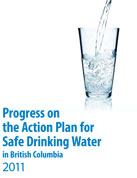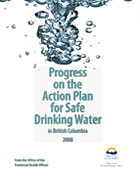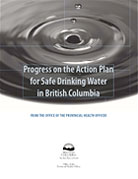Summary Description
Provincial Health Officer's Annual Report: Progress on the Action Plan for Safe Drinking Water (2011) (PDF, 3.2MB)
The report covers programs during the 2007-08 and 2008-09 fiscal years, and is a mandated function of the PHO under the Drinking Water Protection Act.
 Highlights from the report
Highlights from the report
The report highlights progress made on the Province’s drinking water quality goals set out in the Action Plan for Safe Drinking Water. For example:
- No community outbreaks of water-borne illness related to drinking water systems were reported during the reporting period.
- The number of water systems with valid operating permits increased by over 1,000 to a total of 4,539 in March 2009. In addition, the number of systems with an emergency response plan increased from under 1,500 in 2007 to over 2,500 in 2009.
- The number of boil-water advisories increased from 480 in 2006 to 604 in March 2009, reflecting increased emphasis on assessing small systems and ensuring that those failing to meet safety criteria were issuing appropriate advisories to their customers.
- Regulations under the Environmental Management Act were introduced or updated and include measures that will serve to protect drinking water.
- The Ministry of Environment continued to develop water quality guidelines for specific water quality variables in source water, and established water quality objectives to protect the most sensitive water use at a specific location.
- During the reporting period, the Ministry of Community and Rural Development provided 101 grants to communities to help them plan for improvements to their drinking water systems.
- Regional drinking water teams were established in each of the regional health authorities to ensure co-ordination across ministries.
- The Water Action Plan for B.C. was finalized.
Despite this progress, there remain challenges that continue to need further work. For example, data collection and reporting at a regional and provincial level continues to be an issue. However, health authorities have been working to make improvements to their information management systems.
In addition, there remains a lack of drinking water infrastructure in some smaller communities. However, protocols do exist to allow transfer of water systems to local government as local service areas, with full access to infrastructure grants.
Go back >
Provincial Health Officer's Annual Report: Progress on the Action Plan for Safe Drinking Water (2008) (PDF, 10MB)
This report charts progress made on each of the eight key principles in the provincial government's Action Plan for Safe Drinking Water during the 2005/2006 and 2006/2007 fiscal years.
 Highlights from the report
Highlights from the report
- Most British Columbians live in a small number of urban centres and receive high quality drinking water from a few large drinking water suppliers
- British Columbians who live in small communities or remote areas or who are served by water from their own wells are generally the ones who face challenges with their water supplies
- During the reporting period, significant progress has been made to address many of the gaps identified in the 2007 Progress Report on the Action Plan for Safe Drinking Water in B.C.:
- Regulatory amendments were made to the Drinking Water Protection Regulation to better protect public health and source waters
- Investments were made by the Ministry of Health and the Ministry of Environment to increase human resources and to provide education and training of the drinking water officers
- Incremental progress was made towards a drinking water information management solution
- Much remains to be done to improve the safety of our drinking water and this report provides further recommendations for future progress
Go back >
Progress on the Action Plan for Safe Drinking Water in British Columbia (2007) (PDF, 2.2MB)
This report provides a progress report on the Action Plan for Safe Drinking Water in British Columbia, and considers the status of drinking water protection since the implementation of the Drinking Water Protection Act and covers the fiscal years 2003/4 and 2004/5.
 Highlights from the report
Highlights from the report
- In 2003, Drinking Water Protection Act came into force and designated the Ministry of Health as the lead agency for drinking water issues within the province
- Substantial progress was made during the 2003/2004 and 2004/2005 fiscal years by the addition of 20 public health professionals specializing as drinking water officers and 137 new operators who run the province’s drinking systems
- Provincial budget also increased by $2 million per year in order to implement the Act
- Significant obstacles to fully implementing the Act still remain with gaps in accountability and information gathering, lack of true cost-accounting systems, sheer number of small water systems in B.C. as well as the resources required to access training
- Accountability framework based on a system recommended by the Auditor General will help track government’s performance in meeting the requirements of the Drinking Water Protection Act
